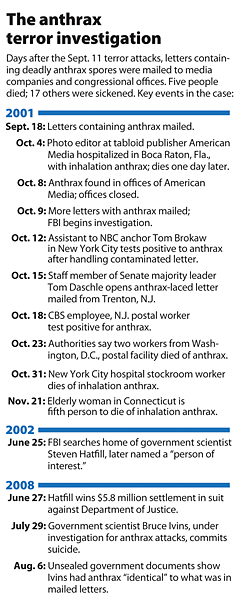How did anthrax suspect Ivins keep security clearance?
Loading...
| Washington
Army microbiologist Bruce Ivins may or may not have been the anthrax killer. But FBI documents about his case released Wednesday raise another troubling question: Why did he retain security clearance and access to deadly pathogens, despite years of strange – sometimes disturbing – behavior?
It is possible Dr. Ivins's superiors were unaware that he had sought help for mental-health problems as early as 2000. And perhaps the FBI did not want to alert him to their suspicions by starting a formal clearance review.
It is also possible that family members and co-workers were reluctant to report his actions. Sometimes, people don't take the security clearance process as seriously as they should, says a lawyer who handles similar cases, even at a facility as sensitive as Ivins's workplace.
"It's an exceptional case. It could be that it just slipped through the cracks," says attorney Mark F. Riley, a retired Army intelligence officer.
Ivins's security clearance and access to labs at Fort Detrick's US Army Medical Institute of Infectious Diseases were not pulled until November 2007, according to Justice Department officials. Ivins committed suicide last week as the US government readied charges against him.
Yet the FBI had requested a sample from a flask of anthrax spores which Ivins held as early as 2002. In April 2004, after discovering that the samples Ivins submitted in fact had not come from the requested flask, RMR-1029, an FBI agent accompanied Ivins into a biocontainment suite at Fort Detrick to seize the flask.
Asked at an Aug. 6 press conference why Ivins was allowed to retain access to anthrax, Jeffrey Taylor, US attorney for the District of Columbia, said, "When the investigation began to focus on Dr. Ivins, the lab was notified of our concerns about him."
Portrait of a scientist
According to documents released Aug. 6, Ivins was having personal problems long before the FBI zeroed in on him – and even before the anthrax atttacks.
In e-mails from 2000 released by the government, Ivins described feeling disassociated from himself. He occasionally became dizzy, he said, and had a strange metallic taste in his mouth.
"Other times it's like I'm not only sitting at my desk doing work, I'm also a few feet away watching me do it," he wrote to an unidentified friend on April 3, 2000.
The attacks of Sept. 11, 2001, appeared to affect him greatly. In December 2001, he send a co-worker some poetry he had composed.
"I'm a little dream-self, short and stout/I'm the other half of Bruce – when he lets me out," one poem began.
At the time Ivins was in therapy for his problems, according to the FBI. It is not clear whether he had been referred to therapy by the Army, or sought treatment on his own.
Nevertheless, for years the scientist retained access to the stocks of deadly microorganisms at Fort Detrick as he worked on an anthrax vaccine. He maintained at least a façade of normalcy to many of his neighbors and co-workers.
The microbiologist, who had worked on developing an anthrax vaccine, was respected by fellow scientists and received a top Defense Department award in 2003 for his research at Fort Detrick.
"It does remind us we need to be careful about who works on this stuff," says Gerald Epstein, a senior fellow in the Homeland Security Program at the Center for Strategic and International Studies.
At the same time, if Ivins was seeking out help on his own, that might have been an easy matter to conceal from the Army, notes Mr. Epstein.
"It's hard to look inside people's minds," he says.
Restricting lab access
An Army fact sheet provided to a reporter in response to a question about Ivins and his access to pathogens notes that he would have been subject to continuous evaluation from supervisors and fellow workers.
Medical treatment undertaken outside the Army as well as the taking of prescription medication could potentially result in a worker at the Fort Detrick labs being denied access to pathogens, notes the fact sheet.
"If a supervisor observes that an employee is under a great deal of stress, seems unusually distracted, or is exhibiting other signs of strain, the employee's entry privileges can be temporarily suspended until the situation is resolved," says the fact sheet.
The Army document notes only that Ivins's access to anthrax and other pathogens was pulled on Nov. 1, 2007, and does not explain whether his superiors had earlier suspicions about him.
Given the secrecy that has surrounded the anthrax investigation, it is possible that the whole story with regard to Ivins and his continued Army work has not yet been told, says attorney Mark Riley.
"Maybe the FBI did not want to alert him," he says.
Generally speaking, the Army does not wait to take action if a problem is identified, says Riley. And if it had begun a separate action to lift his clearance, information about it would be subject to privacy regulations, which are stringent.
A court proceeding against Ivins would have produced much more material about the investigation, perhaps answering the question as to why he maintained a security clearance despite years of deteriorating mental health.
But even without such a trial, the Defense Department might now want to revisit its clearance procedures. And that raises yet another issue, according to Epstein of CSIS. Even if the FBI convinces most people in the US that Ivins was the anthrax killer, the government should not relax about biosecurity in general.
"I think there is a danger in assuming that if this is the guy, we've solved the problem [of vulnerability to anthrax and other pathogens]," says Epstein.






